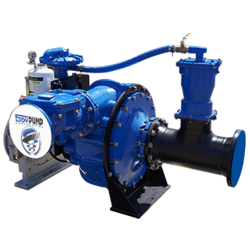Application of EDDY Pump in the Textile Industry



Application of Our Slurry Pumps in the Textile Industry

- Dye and Pigment Handling: A slurry transport pump can transport dye and pigment slurries, which are commonly used in dyeing and printing processes in the textile industry. These slurries often contain solid particles of colorants that must be mixed and transported using a high solids pump without clogging.
- Chemical Additive Delivery: In textile manufacturing, various chemical additives are used for processes like sizing, finishing, and treatment of fabrics. An industrial slurry pump can deliver these chemical additives in slurry form to ensure uniform application onto the materials.
- Wastewater Management: Textile manufacturing processes generate significant amounts of wastewater containing suspended solids, dye residues, and other contaminants. A submersible slurry pump can transfer these wastewater slurries to treatment facilities or for proper disposal.
- Fiber Blending and Preparation: Some textile processes require blending different types of fibers or mixing fibers with additives. An abrasive handling pump can mix fibers and additives in slurry form, ensuring a homogeneous blend before further processing.
- Filter Press Feeding: An abrasive handling pump feed filter presses that separate solids from liquids. In the textile industry, filter presses might be used to dewater sludges or recover dye residues from wastewater.
- Synthetic Fiber Production: Synthetic fibers involve melting polymer chips or pellets and extruding them through spinnerets. A high solids pump can transport the slurry of melted polymer, ensuring a continuous flow for extrusion.
- Coating and Finishing: The slurry transport pump can transport slurries containing fabric coating and finishing chemicals. These processes include applying water repellents, flame retardants, or other protective coatings to textiles.
- Sludge Handling: Some textile processes generate sludges or solid residues that must be transported for disposal. A heavy-duty slurry pump can handle these sludge slurries, making it easier to manage waste products.
- Printing Paste Preparation: In textile printing, pastes are prepared by mixing dyes or pigments with a suitable medium. Slurry pumps can combine and transport these pastes for screen or roller printing.
CALL FOR SALES OR SUPPORT
If you need help with Pump Selection, Sales or Engineering Support
Call 619-345-5446

Application of EDDY Pump’s Hydraulic Dredging in the Textile Industry

- Wastewater Treatment Ponds: Some textile manufacturing facilities might have wastewater treatment ponds or lagoons where wastewater is treated before discharge. Over time, sediment and sludge could accumulate at the bottom of these ponds. In such cases, pond dredging equipment might remove the accumulated solids and maintain the treatment system’s capacity.
- Water Intake Channels: If a textile facility uses water from a nearby river or lake for its processes, there could be instances where sediment buildup in the water intake channels affects water quality or flow. A slurry pump dredge might clear these channels and maintain a steady water supply.
- Plant Infrastructure: Textile facilities with their own water bodies or drainage systems might encounter sediment accumulation in those areas. Hydraulic dredging equipment could be used for maintenance, although mechanical methods like excavation and vacuuming are more commonly used.
- Water Recycling Systems: Some textile processes involve water recycling and reuse. If a recycling system incorporates a settling or sedimentation tank where solids accumulate, a slurry pump dredge might periodically remove these solids to maintain system efficiency.




